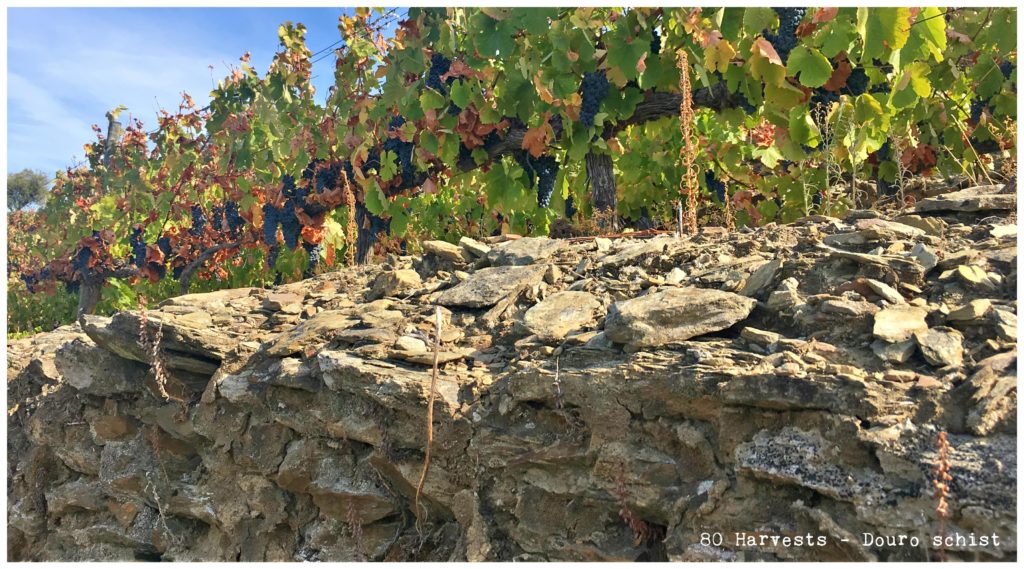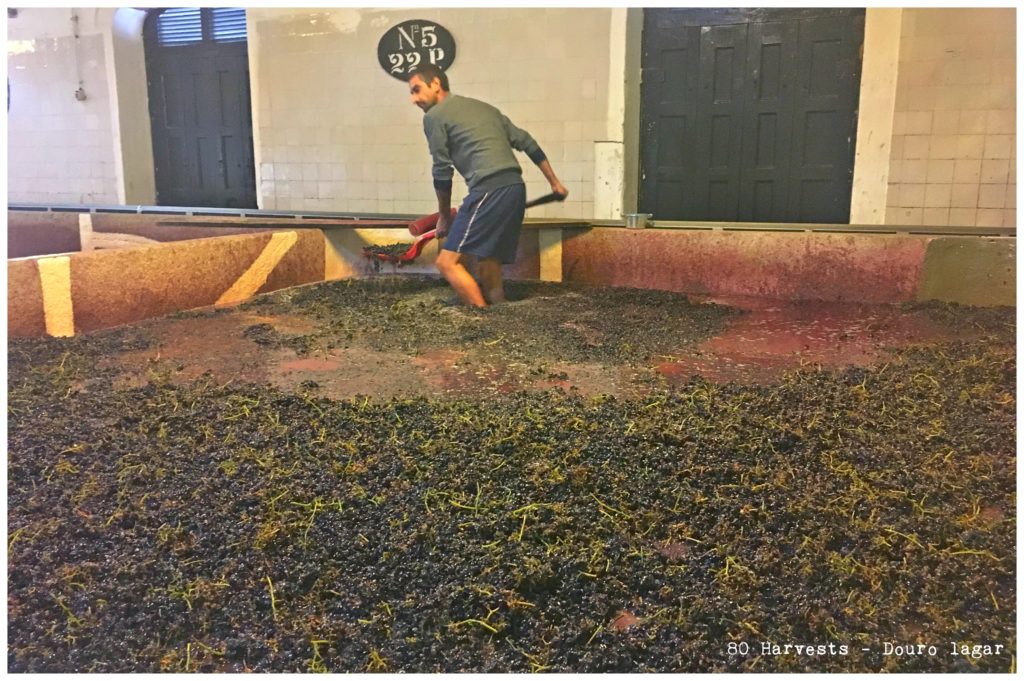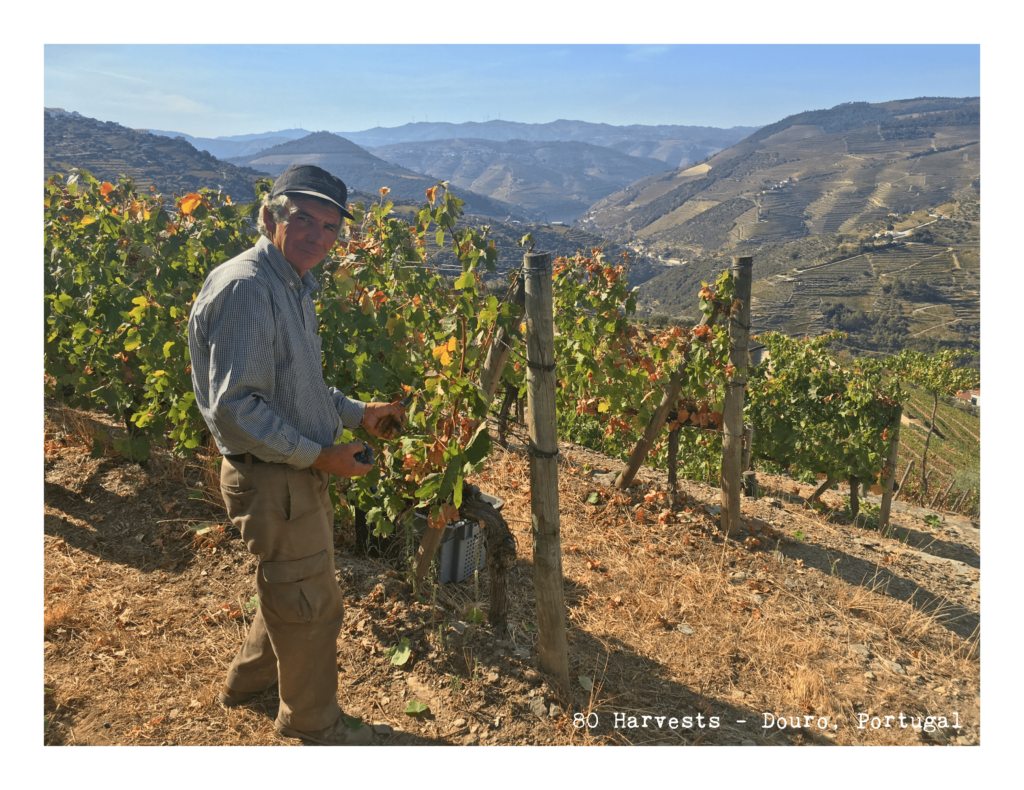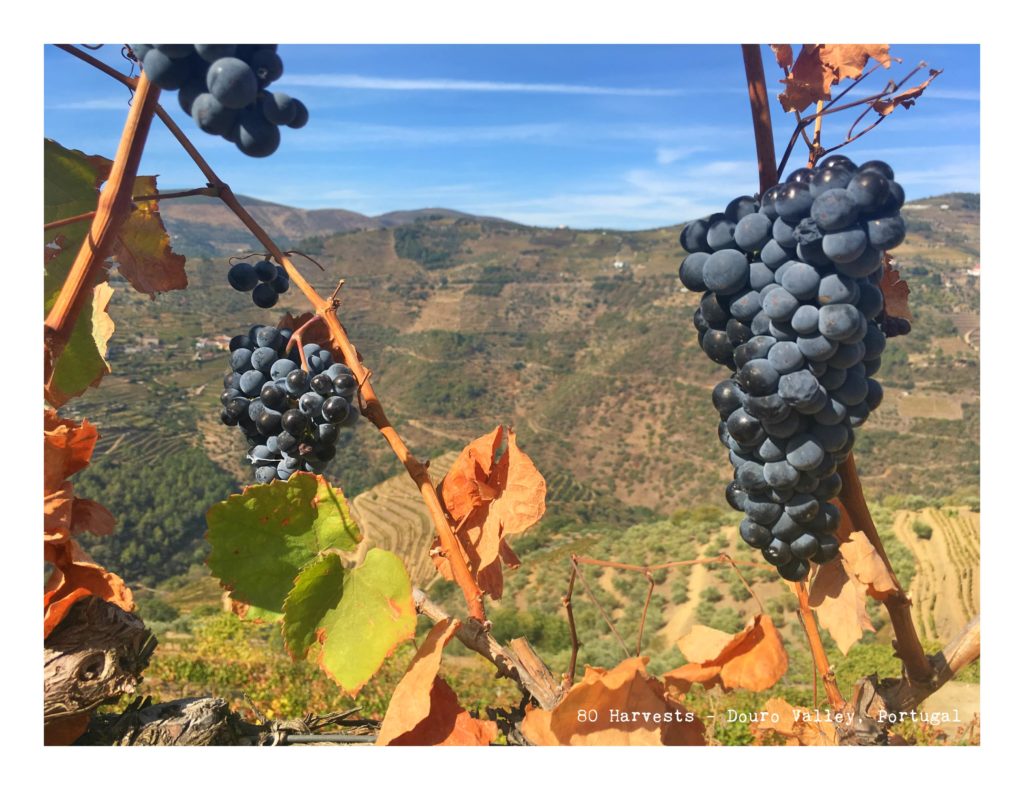How is Port made and what are the terroir essentials of the Douro? This Fast Facts is a Douro study guide to the viticulture and winemaking in Portugal’s Douro Valley where Port is made. Learn about the climate, soils, vineyard training systems (the patamares, socalcos and vinha ao alto), winemaking and ageing of wine and Port in the Douro. This content is being offered as a free preview of what you can enjoy as a subscriber – we hope it will entice you to support 80 Harvests by joining as a member!
The Essentials of Terroir: Douro Study Guide
Climate & Landscape
The Douro valley runs east to west, following the Douro river, from the Spanish border towards the aptly-named port city of Porto (or Oporto in Portuguese). Spanning over 100 kilometres east to west, the climate of the Douro Valley varies significantly and is split into three regions: the Douro Superior (the Upper Douro, which is furthest east, on the border with Spain); the Cima Corgo (Upper Corgo, which sits in the middle) and the Baixo Corgo (Lower Corgo, which is the westernmost part of the valley).
All three regions share a continental climate with very hot summers and very cold winters, however, it is much hotter and drier towards the east in the Douro Superior and much wetter and milder towards the west in the Baixo Corgo.
Temperatures
While the winter is cool (average 9°C daytime), the summer months (August-October) can be excruciatingly hot (reaching over 40°C some days). The locals say they have ‘nove meses de Inverno e tres meses de Inferno‘ (nine months of Winter and three months of Hell). There can be a temperature variation of sometimes 15°C between the temperature close to the coast, and that of the Douro.
Rainfall in the Douro
The Douro Valley is protected from the maritime climate and heaviest rainfall by the Marão mountain range. However in the Baixo Corgo you find a much wetter climate and therefore the rainfall ranges from 1,200mm per year in the Lower Corgo (Fontes) to 380mm in the Upper Douro (Barca d’Alva). Drought years can also seriously diminish rainfall.
Soils of the Douro Valley
 The soils in the Douro is a rocky schistose soil mixed with granite, which is particularly known for absorbing and retaining heat – helping the grapes ripen even more.
The soils in the Douro is a rocky schistose soil mixed with granite, which is particularly known for absorbing and retaining heat – helping the grapes ripen even more.
Latitude
Pinhão: 41.19° N
Longitude
Pinhão: 7.5462° W
Altitude of Douro Valley
This ranges dramatically depending on where the vineyard is planted, as they are almost all planted on slopes of the valley. The altitude and elevation of vineyard plantations can vary from 100m to over 900m above sea level.
Harvest in the Douro Valley
The harvest usually takes place over a month usually starting in September and finishing before November. The 2017 harvest was one of the earliest on record as it started at the end of August due to the accelerated ripening process due to a lower yield caused by the ongoing drought. To get an idea of what harvest looks like in the Douro, take a look at our 360-degree harvest video from the vineyards (make sure to spin your screen!)
Size of Douro Valley
The Douro Valley spans over 250,000 hectares, however, less than a fifth of that is under vine (approximately 40,000 hectares – but estimates vary wildly). Only 26,000 hectares are permitted for Port production, the rest is used for wine production.
Douro Superior: <10,000 hectares
Cima Corgo: <20,000 hectares
Baixo Corgo: <14,000 hectares
Viticulture Facts & Vineyard Management: Douro Study Guide
Two-thirds of the planted vineyards in the Douro are on an incline above 30% which means that erosion is a significant concern and the vineyard training systems have been developed with the steep slopes in mind.
Watch this video to see and understand the difference between the main vineyard training systems in the Douro – socalcos, vinha ao alto and patamares:
Ana Carvalho explains: “The most modern way of planting is vertical planting, or in Portuguese, we call it Vinha ao alto. You plant like if you were in a flat area, and this is possible at the top of the hill because it has less than a 30% inclination. And in this way we can mechanise the work – you have more space between rows, and we can have more plants per hectare compared to our old way of planting.
“Patamares, are made with caterpillars, with bulldozers, and you have the mother rock on the surface – two rows per terrace. You can also access them with the tractor, and this type of planting is used since the 1970s, more or less.
“And a long time ago, in the nineteenth century and eighteenth century, they used to do stone walled terraces called Socalcos. Socalcos are UNESCO protected, they are a world heritage. And the walls are made by hand, stone on stone, without cement. And they have stairs between them, so until today we still have to carry the boxes filled with grapes on our back to harvest those plots. That’s the oldest way of planting, and that’s how things were done two hundred years ago here.
“If you are going to start a new vineyard, you are probably going to choose either Patamares or Vinha ao Alto because you can pass the tractor through, so it makes our life easier. In Socalcos everything is done by hand, it is very labour intensive!”
Vineyard classification of the Douro
Only 26,000 hectares of vines are permitted for Port production and they are classified by the IVDP. The classification uses a 1200-point system and takes into the account the vineyard’s soil and microclimate, the age of the vineyards (minimum 5 years old), vine density and the quality potential. The vineyard is then given its quota, or beneficio, of the amount of Port wine that can be produced from that plot that harvest.
Vine training method in the Douro
Vines are usually trained low, close to the ground, and use the single or double Guyot training method.
Yield in the Douro
The Douro valley has a naturally low yield due to the dry, hot conditions with poor, rocky soils. The maximum authorised yield is 55 hl/ha (7 500 Kg/ha), however, in reality, the average yield is far less – approximately 30 hl/ha (4 100 kg/ha).
Douro Study Guide: Grape Varieties
The most planted and important varieties in the Douro are:
Red grape varieties in the Douro
- Touriga Nacional: Most prestigious variety. Good structure, tannin, acidity, aromatics. Was widely planted until phylloxera. Popular in the Dao too.
- Touriga Francesa: Also known as Touriga Franca. Lighter bodied and more aromatic than Touriga Nacional. Most widely planted variety.
- Tinta Barroca: Naturally high sugar levels (good for higher alcohol levels), high yielding, adds volume and sweeter fruit notes. Third most-planted variety in the Douro.
- Tinta Roriz: Also known as Tempranillo (in Spain). Adds colour.
- Tinto Cão: Adds spice and bite, better for long ageing.
- Tinta Amarela: Also known as Trincadeira. In decline in Portugal because hard to make in vineyards.
- Vinhao: Also known as Sousao.
- Mourisco Tinto: Parent of Touriga Franca and still found in small proportions.
Learn about the different wine varieties in the Douro as winemaker Carlos Agrellos discusses the different qualities of Touriga Nacional, Touriga Franca and Tinta Roriz in this interview clip:
White grape varietals in the Douro
- Malvasia Fina: Subtle and fresh, usually used in blends.
- Viosinho: Full bodied, fresh and fragrant whites.
- Donzelinho: Used in white Port.
- Gouveio: Fresh, lively and high acid wines with citrus notes. Confused with Verdelho for a long time.
- Rabigato: Bright, refreshing acidity with mineral character and full body.
Discover what are the highest quality white wine varieties in the Douro by watching this short interview. Winemaker at Quinta do Noval, Carlos Agrellos, discusses the different qualities of white wine varieties in the Douro (Malvasia Fina, Gouveio, Viosinho and Rabigato):
Following phylloxera rootstocks in the Douro were generally replaced by Rupestris du Lot, and later by hybrids (420-A, SO4, R99, R 11O, 1103 P and 196-17).
Douro Study Guide: Winemaking
Port production has a very rapid fermentation and maceration process, traditionally in lagars and foot trodden (see a 360-degree video in the lagar here!), for just a day or two before it is fortified, while still sweet, and moved into large vats.

The decision is then made as to whether this wine continues its journey as a Ruby or Tawny Port and the ageing process determines the style it becomes. In this video interview (for members only) winemaker Carlos Agrellos discusses every stage of the winemaking process in depth and it includes videos of the process as it happens:
[mepr-hide if=”rule: 2080″]
…
This content is exclusive for Members. Take a look at the introductory packages below to become a Member of 80 Harvests and get unrestricted access to all our content.
Thank you for supporting the journey and being part of the 80 Harvests community!
[mepr-group-price-boxes group_id=”2070″]
[/mepr-hide]
[mepr-show if=”rule: 2080″]
Don’t forget your member password for videos:
wineworld
Enjoy & thanks for supporting 80 Harvests!
[/mepr-show]

Douro Study Guide: Wine Styles
Ruby Style
Deep-coloured red wines made with red grape varieties. They are mainly aged in bottle and maintain red and black fruit aromas.
- Ruby: The most basic category, usually the cheapest, and the biggest production. Usually stored in stainless steel tanks, and sold young (only aged 3 years).
- Reserve: Premium ruby port.
- Late Bottled Vintage (LBV): Vintage port which has been left in cask for 4-6 years and then bottled.
- Crusted: Unfiltered blend of vintage ports.
- Vintage: Declared vintage port and aged in bottle for several years.
- Single Quinta Vintage: Single-vineyard vintage.
Tawny
Cask-aged ruby ports that turn a brown-amber-gold depending on their age and the amount of oxidation. The oxidation in cask over time develops more nut, spice and matured fruit aromas.
- Tawny
- Tawny Reserve:
- Age designated: These tawny ports have the average age in cask on the bottle (10 year, 20 year, 30 year, 40 year etc) and are made from blends of vintages.
- Colheita: Single-vintage tawny port, often aged for a very long time.
- Garrafeira: Single-vintage tawny port that has spent a minimum of 3-6 years in cask, and 8+ years in bottle.
White Port
Made with white grapes. Usually sold very young and often used for cocktails (a Port and tonic).
Rosé Port
A new category developed in 2008 by Poças and Croft. Sweet and slightly pink following a short maceration on the skins.
Douro Study Guide: Production

Number of Farmers
33,000 farmers (average plot size is 1 hectare). The region is known for having small farmers and producers mainly buy grapes (rather than owning the land). The larger vineyards are in the Upper Douro.
Number of Quintas
There are over 200 quintas (wine estates with producing facilities) however the majority of Port production is concentrated in the large port houses.
Interesting Facts
- The Douro was the first demarcated wine region in the world, announced by the Marquis de Pombal in 1756.
Did you find our Douro study guide useful? 80 Harvests is an independent wine publication bringing you guides to wine regions around the world. Please help support the journey by becoming a member and get access to more study guides, winemaker interviews and features.
More on the Douro:
Thank you to Quinta do Noval for hosting us in the Douro during the harvest 2017 and enabling us to create this Douro study guide from the region.


